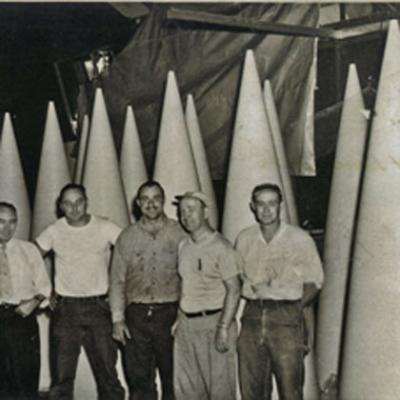
Before there were Skis on Vashon

“Oh-No, another red light”, I said to myself, as I pushed hard on the brake pedal, trying to stop my 38 Pontiac for the light. The mercury in the back seat slopped yet another time and rolled out the rusty holes in the floorboards to grease the street between East Marginal Way and the Fauntleroy ferry dock.
It was the best summer job I had ever had at the tender age of 17, working under a navy contract, all was hush-shush in 1957.
Warren Philbrick and Ed Strickland were manufacturing Atlas missile-nose cones in the old Burton school and I was the “gopher”; go for this and go for that, sweeping floors in my spare time.
The vertical lathe they used to grind the nose cone to government specs was 10 feet high in the basement of the old school. Vibration from the lathe was throwing off the tolerances, when the specs called for no more variation than the thickness of half a human hair. The thought then, was to float the lathe bed on mercury to dampen the vibration and take the wobble out. I was sent to Sternoff Metals on the Duwamish Slough to pick up 300 pounds of mercury.
I pulled into the muddy junk yard and asked the foreman where the mercury was for pick-up. He directed me to a pile of 75 pound steel flasks that had come down from Alaska where it had been used in the mines.
My great uncle Carroll mined for gold on the Columbia River in the thirties and used an old “one-lunger” to pump river water to his sluice box. Chuc, chuc, chuc-poow went the old engine, mimicking the sound of a one-lunged-man. Carroll took the sand mixed with gold from the sluice box and worked mercury into it producing an amalgam. He would halve a large potato and dig out most of the insides, leaving two holes on top for ventilation. The ball of amalgam was then placed on the top of a hot stove with the potato over it, causing the mercury to boil off into the potato and leaving a piece of slag on top of the stove, called “dirty gold”-the fumes from the potato were deadly poisonous, though my uncle lived into his 80’s.
My car was a 1938 Pontiac 4-door that had cost me $50, a straight eight. I had removed the rear seat to have more room to haul; but the floor boards had rusted out so you could see the street. I started for the car with a flask of mercury when the foreman stopped me. “Where are you going with that”, he said. “You don’t get the flasks”. “What the hell do you think I’m going to do with the mercury”, I asked. He pointed to a pile of old baking pans of all different sizes. “Use those”, he said. I lined the back seat with an assortment of pans and filled them with mercury. It was the only thing I could do.
The trip to Vashon was a nightmare. Mercury is very heavy and very slippery. Every bump or sharp stop caused it to slop in the pans. I laid a strip of mercury all the way to the Burton school where it was poured onto a large tray under the lathe bed and took the vibration out of the grinder.
I had worked for Philbrick and Strickland the year before, at what is now the K2 sight, where the company had a navy contract to build mine sweeper floats. A mine sweeper would tow the 12 foot floats on long cables to either side of the ship to pick up or detonate floating mines.
We had a small room in the back of the building where Kirschners built fiberglass dog cages for veterinary use. The mine sweeper float was supposed to be secret, but everybody knew about it. The float was in the shape of a long green cocoon, which is the way it was made having been spun out of thick glass threads as the float was turned on its axis and smelly and sticky resin was applied to its sides. The resin was everywhere because it was hard to manage and dripped on the floor making an awful mess, impossible to clean. The soles of our boots became layered with the stuff, so if you went to town, everybody knew where you worked.
Every day a new layer of resin-soaked threads would be applied and then allowed to cure overnight. Unfortunately, the new resin would soften the layer from the day before and depressions would form on the surface of the float.
My job was to pound a nail in the thick skin and with a piece of orange hay string, secure the string to another nail pounded into the ceiling and pull out the depression until the float dried and another layer could be applied.
Every time I saw a picture of an Atlas missile or radar dome for an F-104 Convair, I wondered if it was one of ours.
- Login to post comments
